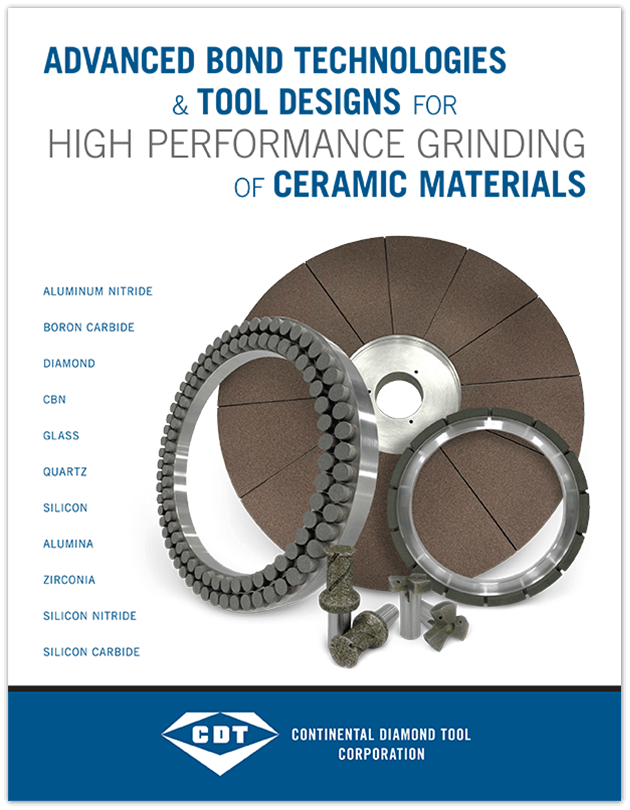Superabrasive Grinding Technology for the Ceramic Industry
The rapid growth of ceramic and carbide components in industries such as Automotive, Aerospace, Medical, and Electronics has created new challenges for grinding professionals. The hardness, abrasiveness, and brittle nature of ceramics and carbides make them difficult to grind efficiently. Yet advancements in superabrasive grinding technology have paved the way for improved grinding processes and reduced cycle times for those that invest in new custom technology. In this article, we explore the transformative impact of custom superabrasive grinding products on the ceramics industry, highlighting the benefits they offer and the cutting-edge technologies driving these innovations.
Overcoming Grinding Challenges in the Ceramics Industry
Ceramic and Carbide materials pose unique challenges when it comes to grinding due to their unique hardness and abrasive properties. Traditional metal bond and resin bond grinding wheels have been the go-to solution for grinding these materials. However, advancements in CNC grinding equipment and the introduction of new bond systems have revolutionized the way ceramic and carbide components are ground.
In different industries like electronics, optics, aerospace, and advanced manufacturing, people are using carbide and ceramic coatings to make components last longer and better at handling heat. Two common ways to add these coatings are HVOF (High-Velocity Oxygen Fuel), which uses high-speed flames to spray the coating onto surfaces, and HVOC (High-Velocity Oxygen-Fuel Cold Spray), which works at lower temperatures with fast-moving gas. Another method is Chemical Vapor Deposition (CVD), where a thin layer of material is deposited on a surface through chemical reactions in the vapor phase. Using CVD or HVOF/HVOC can make components longer lasting and more wear resistant.
The inclusion of carbide or ceramic layers necessitates special consideration during the grinding process because of the inherent hardness and abrasive properties of these materials. Superabrasive grinding wheels offer superior performance in grinding these materials by reducing grinding forces, lowering power consumption, and minimizing subsurface damage. These innovative grinding products are particularly effective in reducing grinding cycle times and reducing scrap, resulting in significant cost savings and enhanced productivity.
Advances in Superabrasive Grinding Technology
The advent of multi-axis CNC grinding with Rotary Dressers has automated grinding processes, increasing efficiency and accuracy. Spindle & High-Pressure Coolant systems have improved the delivery of coolant to critical grinding areas, optimizing swarf removal and improved the cooling and lubrication during the grinding process. High-speed grinding spindles enable a wider range of bond technology and wheel sizes to be used for ID and smaller part grinding.
New "Cutting Tool" designs, such as slotting, high porosity bonds, coolant holes, and CNC adaptors for improved rigidity, have improved tool life and performance. These designs enhance coolant flow, chip evacuation, and overall tool effectiveness, contributing to longer tool life and reduced downtime.
Innovative bond systems have been developed to address the unique challenges of grinding ceramic and carbide materials. These new bonds lower grinding forces, reduce power consumption, and lead to faster cycle times. They also minimize subsurface damage resulting in lower scrap rates while enhancing the quality and integrity of the finished components.
Superabrasive Grinding Products for Ceramic & Carbide Components
CDT's superabrasive solutions deliver significant benefits, including a reduction in grinding forces by 30% or more (compared with resin & metal bonds), reduction in cycle times by up to 50%, and significant reduction in scrap rates on these critical and costly components. These advancements help manufacturers optimize their grinding processes, increase productivity, and reduce costs.
Continental Diamond Tool (CDT), a leading provider of superabrasive solutions, offers a comprehensive range of grinding products designed specifically for the ceramics & carbide industries. Their products are compatible with major industry equipment manufacturers, including Studer, Kellenberger, Danobat, Walters, ANCA, Junker, Okuma, Koyo, USACH, Lapmaster, Peter Wolters, SpeedFam, Stahli, Supfina, and many more. CDT also offers advanced custom tool designs, such as cross cutters and hole drilling with flat bottom drills, to address specific grinding requirements. Their expertise extends to a wide range of equipment, including round tools for Anca, Haas, ITM, Normac, Rollomatic, Star, and Walters, as well as inserts for Agathon, Coborn, EWAG, Waida, and Wendt. Additionally, CDT has created surface grinders for Arter, BLOHM, Brown & Sharp, Chevalier, ELB, and Magerle, as well as Blanchard grinders for Blanchard, Bourn & Koch, and DCM.
Superabrasive grinding products have revolutionized the ceramics & carbide industry, overcoming the challenges presented by the high hardness and abrasive nature of these materials. With reduced grinding forces, faster cycle times, and reduced scrap rates, manufacturers can achieve greater efficiency, productivity, and cost savings. Continental Diamond Tool's advanced superabrasive solutions provide tailored grinding products for a wide range of equipment, enabling manufacturers to optimize their grinding processes and achieve exceptional results. As industries continue to evolve to use more ceramic & carbide materials, the use of superabrasive grinding products will undoubtedly play a crucial role in meeting the growing demand for efficient production of these components.

